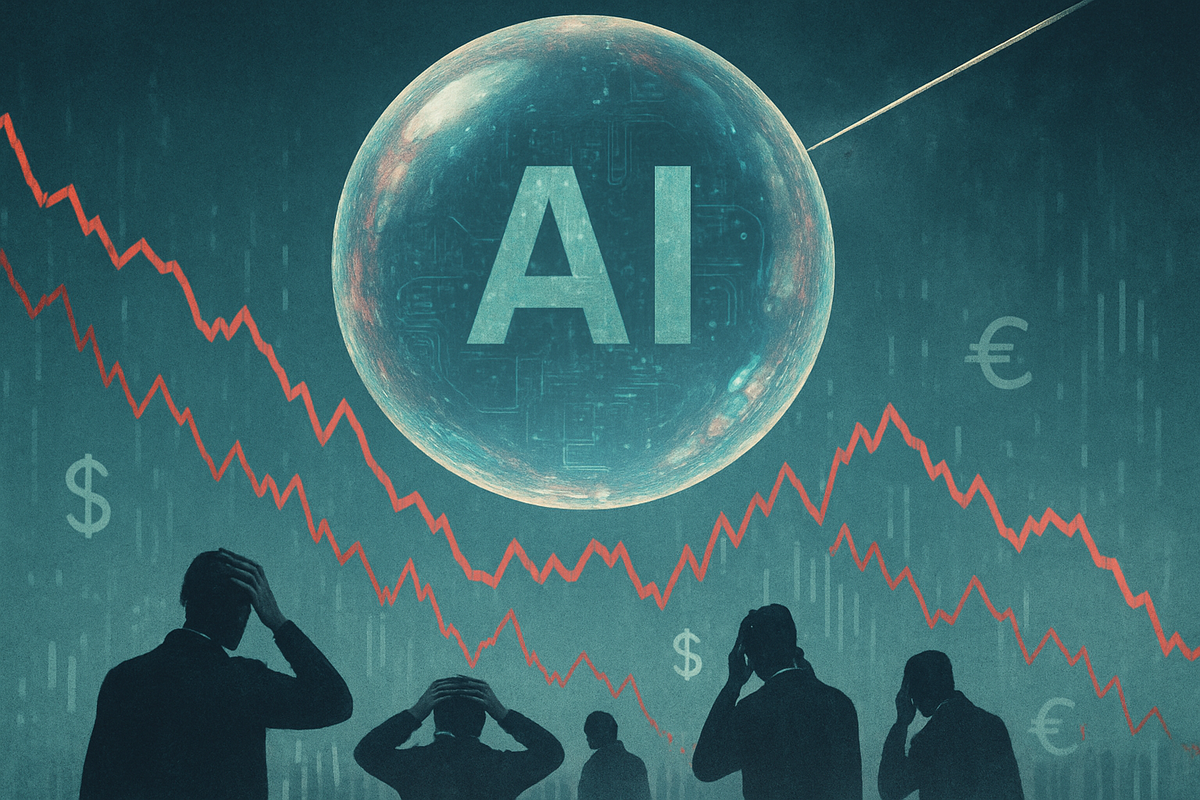
As October 2025 unfolds, a palpable sense of unease is permeating global financial markets, with growing fears that the exuberant rally in Artificial Intelligence (AI) companies may be inflating a speculative bubble poised for a dramatic burst. Drawing unsettling parallels to the dot-com era, financial titans and industry leaders are sounding alarms over stretched valuations, market concentration, and a potential disconnect between massive AI investments and tangible returns. The immediate implications point to heightened volatility and a looming recalibration that could significantly impact investor portfolios and the broader economy.
This escalating caution comes amid a period of intense innovation and investment in AI, which has propelled the valuations of leading technology firms to unprecedented heights. While the transformative potential of AI remains undisputed, a chorus of influential voices, from central bankers to tech moguls, suggests that the market's enthusiasm may have outpaced fundamental realities. The specter of a "sudden correction" hangs heavy, threatening to unravel significant capital gains and redefine the investment landscape for the foreseeable future.
Unpacking the AI Frenzy: Alarms from Wall Street to Silicon Valley
The current climate of apprehension is not without substantial grounding. Throughout 2025, numerous indicators and expert opinions have converged to paint a picture of an increasingly speculative AI market. The International Monetary Fund (IMF) and the Bank of England have both issued explicit warnings about the risk of a sharp market correction driven by overvalued AI assets. Kristalina Georgieva, the IMF's managing director, cautioned that the bullish sentiment around AI's productivity could "turn abruptly," while JPMorgan (NYSE: JPM) CEO Jamie Dimon advised that "most people should feel more uncertain about the future."
Adding to these institutional concerns, even figures within the AI industry have acknowledged the frothiness. OpenAI CEO Sam Altman admitted that "many parts of AI that I think are kind of bubbly right now," though he maintains conviction in the technology's long-term value. Amazon (NASDAQ: AMZN) founder Jeff Bezos likened the current enthusiasm to a "bubble," where "every experiment gets funded, every company gets funding, regardless of the quality of the ideas." This environment has led to a market where nearly 40% of the US equity market's capitalization is concentrated in a handful of mega-cap companies heavily invested in AI, leaving the market vulnerable to any slowdown in AI growth.
A particularly jarring revelation emerged from an August 2025 Massachusetts Institute of Technology (MIT) report, which concluded that approximately 95% of the colossal investments in generative AI have yet to yield substantial returns, with only about 5% of implemented AI systems delivering real value. This finding, which "rattled" investor confidence, highlights a critical divergence between investment hype and practical utility. Furthermore, concerns have mounted over "circular deals" on Wall Street, such as a reported $1 trillion in intertwined financing involving OpenAI, Nvidia (NASDAQ: NVDA), AMD (NASDAQ: AMD), and Oracle (NYSE: ORCL), where companies invest in each other or their users, raising specters of artificial demand and inflated valuations reminiscent of the dot-com bubble's questionable financial engineering. The Nasdaq Composite (NASDAQ: COMP) recently retreated from record highs around October 8-9, 2025, signaling a potential shift in market sentiment and prompting a re-evaluation of investment strategies. Amidst this uncertainty, gold prices have surged to all-time record highs, as investors seek safe haven assets.
The Winners and Losers in a Potential AI Market Correction
A significant market correction in the AI sector would undoubtedly create a distinct divide between companies poised to weather the storm and those vulnerable to substantial losses. The "Magnificent 7" tech giants – Alphabet (NASDAQ: GOOGL), Amazon (NASDAQ: AMZN), Meta (NASDAQ: META), Tesla (NASDAQ: TSLA), Apple (NASDAQ: AAPL), Microsoft (NASDAQ: MSFT), and Nvidia (NASDAQ: NVDA) – are at the epicenter of this discussion. While their deep pockets, diverse revenue streams, and established market positions offer some resilience, their high valuations and significant exposure to AI innovation also make them prime candidates for a substantial repricing if investor sentiment shifts. Nvidia, a key enabler of the AI boom through its advanced GPUs, could face particular scrutiny if demand for AI infrastructure cools or if alternative technologies emerge.
Conversely, companies with robust fundamentals, proven profitability outside of speculative AI ventures, and diversified business models may emerge as relative winners. These could include established corporations in traditional sectors that are cautiously integrating AI to enhance existing operations rather than building their entire valuation on speculative AI growth. Furthermore, smaller, niche AI companies that demonstrate clear, tangible returns on investment and address specific, unmet market needs, rather than relying on hype, could also prove resilient, albeit after a likely period of reduced venture capital funding. The MIT report's finding that only 5% of AI systems deliver real value suggests that companies focusing on this valuable 5% will be the true long-term beneficiaries.
The primary losers would likely be highly leveraged AI startups with unproven business models, those reliant on continuous rounds of venture capital funding at increasingly inflated valuations, and investors who have poured capital into these ventures based purely on speculative growth projections. The "circular deals" identified on Wall Street could also unravel, exposing companies that have artificially propped up each other's valuations. Any significant downturn would likely lead to a drying up of finance for such entities, forcing many into bankruptcy or fire-sale acquisitions. Investors chasing momentum without scrutinizing underlying profitability and sustainable business models could face substantial capital destruction, echoing the dot-com bust where many high-flying startups vanished overnight.
Broader Implications and Historical Echoes
The potential AI tech bubble burst extends far beyond the immediate valuations of individual companies, carrying wider significance for industry trends, regulatory frameworks, and the global economy. The current concentration of market capitalization in a few AI-heavy tech giants—representing almost 40% of the S&P 500—poses a systemic risk. A significant downturn in these companies would send ripple effects across the entire market, impacting not only direct competitors and partners but also venture capital funding for smaller AI startups globally. This mirrors the dot-com bubble's aftermath, where a widespread loss of confidence in tech led to a severe contraction in venture capital and widespread industry consolidation.
Historical precedents, particularly the dot-com bubble of the late 1990s and early 2000s, offer stark warnings. The rapid rise in tech stock prices, the large proportion of tech stocks in the S&P 500, seemingly stretched market valuations, and a "general sense of extreme optimism" are all symptoms now being observed in the AI sector. While proponents argue that today's AI leaders possess more scalable and cash-generating businesses than many dot-com failures, the MIT report's findings on the lack of tangible returns from most generative AI investments suggest a similar disconnect between promise and delivery. The "utterly gargantuan" investment in data centers, driven by the AI industry, is also noted for artificially inflating US GDP, with reports indicating that US GDP growth drops to near zero if this expenditure is excluded—a potential harbinger of recessionary pressures.
Regulatory and policy implications are also coming into focus. Governments worldwide are already grappling with the ethical, societal, and economic impacts of AI. A market correction could accelerate calls for stricter oversight on AI investments, data usage, and market practices, especially concerning potential "circular deals" and artificial demand generation. Geopolitical risks, such as increased US-China trade tensions and tariffs, further complicate the landscape, adding another layer of uncertainty to an already volatile market. The Bank of England has also highlighted the threat of a "sharp repricing of US dollar assets" if the Federal Reserve's credibility is eroded, which could exacerbate any market downturn.
Navigating the Future: Scenarios and Strategic Pivots
Looking ahead, the trajectory of the AI market presents a spectrum of possibilities, from a soft landing to a significant correction. In the short term, continued market volatility, particularly in the Nasdaq Composite, is highly probable. Investors are likely to see a rotation of capital, moving away from high-growth, potentially overvalued AI technology stocks towards more resilient companies with strong balance sheets and consistent profitability, regardless of their AI exposure. This could create opportunities for value investors to acquire fundamentally sound companies at more attractive prices.
In the long term, the genuine, transformative power of AI will undoubtedly continue to drive innovation and economic growth. However, a market correction would force a crucial strategic pivot for many companies and investors. The emphasis will shift from mere adoption and speculative investment to demonstrating clear, measurable returns on AI investments. Companies that can effectively integrate AI to enhance productivity, reduce costs, and create new, sustainable revenue streams will be the ultimate beneficiaries. Those that have simply chased the AI hype without a clear value proposition will struggle.
Potential scenarios include a "sharp market correction" leading to substantial capital destruction and a drying up of finance for households and businesses, as warned by hedge fund manager David Einhorn. Alternatively, a more gradual recalibration could see valuations deflate steadily as companies are forced to prove the economic viability of their AI initiatives. Market opportunities may emerge in sectors providing critical AI infrastructure (like specialized hardware or energy solutions) that can demonstrate a clear path to profitability, even as the broader AI software market cools. Challenges will include navigating a more discerning investment environment and a potential talent drain from less stable AI ventures.
A Crucial Juncture for the AI Market
The growing apprehension surrounding an AI tech bubble burst marks a crucial juncture for the financial markets and the technology sector. The confluence of stretched valuations, concentrated market power, and a concerning lack of tangible returns from many AI investments has created an environment ripe for reassessment. While the underlying technology of AI holds immense promise for the future, the current speculative fervor carries significant risks that cannot be ignored.
Moving forward, investors must prioritize due diligence, focusing on companies with sustainable business models, clear paths to profitability, and a proven ability to generate real value from their AI endeavors. The "palpable shift towards caution" necessitates a careful re-evaluation of investment strategies, emphasizing financial resilience over unchecked growth. The surge in gold prices to record highs serves as a stark reminder of the market's flight to safety and the pervasive uncertainty.
What investors should watch for in the coming months includes further pronouncements from central banks and financial institutions, the performance of the "Magnificent 7" tech stocks, and any concrete data on the return on investment from AI implementations. The market's ability to differentiate between genuine AI innovation and speculative excess will determine whether the current excitement leads to sustained growth or a painful, but ultimately necessary, correction. The lessons of past bubbles underscore the importance of prudence and a long-term perspective in navigating this evolving landscape.
This content is intended for informational purposes only and is not financial advice





